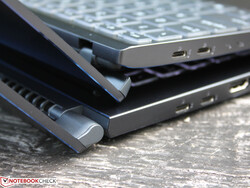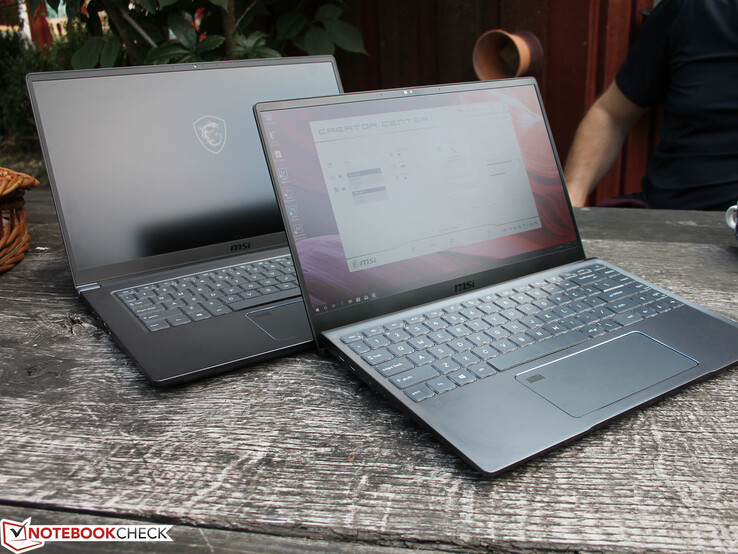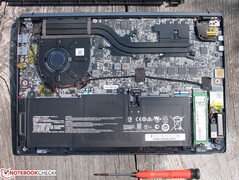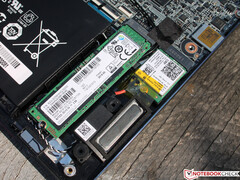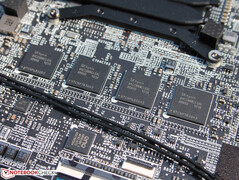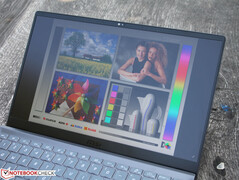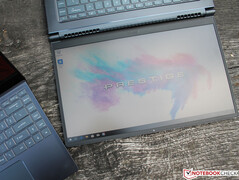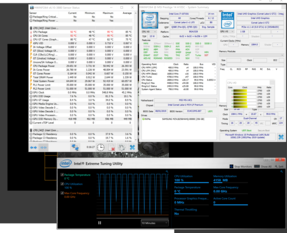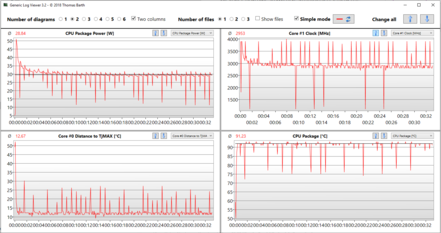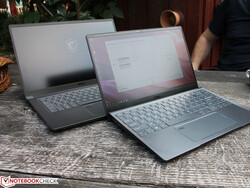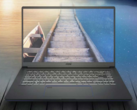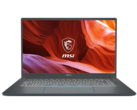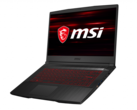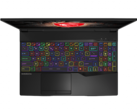MSI Prestige 14 Hands-On Laptop Review: Faster than ever and still great for content creators

The Prestige 14 is MSI’s brand-new 14-inch, and Intel Comet Lake-U powered laptop. Designed for content creators, the Prestige 14 includes a Core i7-10710U hexa-core processor and an NVIDIA GeForce GTX 1650 Max-Q GPU among other components. MSI promises that the Core i7-10710U will deliver up to 50% better multicore performance than its Whiskey Lake predecessor, which is unsurprising considering that it has 50% fewer cores. The Prestige 14 is Quiet Mark Certified too, so it should remain quiet under load, even with its hexa-core CPU and dedicated GPU running at full tilt.
MSI will offer the Prestige 14 with either a 4K or 1080p display. The former covers 100% of AdobeRGB, while the latter covers 100% of the narrower sRGB colour space.
We expect to see more laptops equipped with the Core i7-10710U and a dedicated GPU in the coming months, but the Prestige 14 is the first that we have gotten our hands on. Impressively, MSI has kept the Prestige 14 to just 16 mm (~0.55 to ~0.63 in) thick, but it remains to be seen whether other OEMs will follow suit or perhaps go even slimmer. MSI markets the Prestige series as being suitable for content creators and creatives, but the Prestige 14 is still capable of some light-gaming. In short, the Prestige 14 strikes a balance between powerful hardware without the flashy designs and RGB lighting of modern gaming laptops.
MSI promises that the Prestige 14 will achieve up to 10 hours battery in “Super Battery Mode”, although manufacturer estimates typically fall short of real-world runtimes. We shall test the validity of MSI’s claim in our full review.
The Prestige 14 has no proprietary charging port, with MSI including a 90 W USB Type-C charger instead. The device also comes with an Intel AX201 modem, which utilises 2x2 MIMO antennas and supports up to IEEE 802.11 ax Wi-Fi. The AX201 can also connect to 160 MHz Wi-Fi channels, and theoretically is up to three times faster than IEEE 802.11 ac modems such as the Intel Wireless-AC 9560.
The Prestige 14 series will range from €1,449 (~$1,588) to around €1,899 (~$2,081) when MSI launches it in October. By contrast, the Prestige 15, which will be launched this month, will start at €1,599 (~$1,753).
Please note: MSI Germany has kindly provided us with a pre-production version of the Prestige 14 for our hands-on review. We shall conduct a full review when we receive a retail version. Correspondingly, we shall wait until then before we award the Prestige 14 a full rating.
Case
As mentioned earlier, the Prestige 14 measures 16 mm (~0.55 to ~0.63 in) thick, specifically 15.9 mm (~0.62 in). The device also weighs 1.29 kg, which puts it on par with many of its contemporaries. Likewise, MSI has managed to fit a 14-inch panel into what would previously have been a 13.3-inch chassis, reminiscent of the Dell XPS and ASUS ZenBook series. This is thanks to the small side and top bezels, which yield an almost 90% screen-to-body ratio.
MSI kindly lent us both the Prestige 14 and Prestige 15, allowing us to compare the two devices side-by-side. While the two devices look identical from most angles, MSI has designed the devices with different hinges. The Prestige 15 has a conventional laptop hinge, which does not extend beyond the bottom of the top chassis, although it does push the chassis up by a few millimetres. However, the Prestige 14 has a hinge that raises the chassis by around 1 cm (~0.4 in) from the surface on which it has been placed. Other OEMs such as ASUS and HP have included similar hinges on their laptops, like the Envy 13 that we recently reviewed. The 1 cm (~0.4 in) gap underneath the bottom of the device aids ventilation and tilts the keyboard upwards by 5°, which should also make for a pleasanter typing experience.
The displays in both devices can be opened to 180°, allowing to lie flat on a table, for example. You can also rotate the screen by 180°, which could come in handy if you want to quickly show someone a presentation or a piece of work.
MSI has constructed both devices using sandblasted aluminium, which gives the Prestige 14 and 15 understated looks. The MSI logo, which sits on the display lid, has been subtly integrated too, which is a nice touch. If you missed it, the power button is on the same row as the function keys. Incidentally, MSI will sell the Prestige 14 in Mineral White or Carbon Grey, the latter of which is the colour of our pre-release review units.
Maintenance
The Prestige 14 is relatively simple to repair or maintain, with the bottom case coming away from the rest of the chassis once you have removed a few screws and carefully pried free a few retaining clips. We would recommend using a flat plastic tool such as a spudger to do the latter, as the clips are rather fragile. Once inside, you have access to the battery, fan, heatsink, motherboard, SSD and Wi-Fi module. Sadly, MSI has soldered the RAM, making it irreplaceable. Oddly, the base model, which has no dedicated GPU, has two SO-DIMM slots.
Display
A bright, colour accurate and anti-reflective display is essential for content creation, especially on the go. The Prestige 14 ticks all three, with MSI equipping the device with a 4K panel that it claims covers 100% of AdobeRGB. We were unable to confirm this claim during our hands-on tests, but it does have 100% sRGB coverage. As mentioned earlier, MSI also sells a 1080p display option should you not need a 4K panel.
Our pre-release test unit achieved an average maximum brightness of 513 cd/m² according to X-Rite i1Pro 2 and 568 cd/m² at the centre of the display, both of which are mighty impressive. The panel is 87% evenly lit too, which is on par with its contemporaries. Likewise, the panel has a low black level and high contrast ratio, which we measure at 0.28 cd/m² and 2,029:1 respectively.
| |||||||||||||||||||||||||
Brightness Distribution: 87 %
Center on Battery: 568 cd/m²
Contrast: 2029:1 (Black: 0.28 cd/m²)
ΔE ColorChecker Calman: 3.18 | ∀{0.5-29.43 Ø4.78}
calibrated: 1.14
ΔE Greyscale Calman: 4.79 | ∀{0.09-98 Ø5}
99% sRGB (Argyll 1.6.3 3D)
85% AdobeRGB 1998 (Argyll 1.6.3 3D)
95.4% AdobeRGB 1998 (Argyll 3D)
99% sRGB (Argyll 3D)
81.5% Display P3 (Argyll 3D)
Gamma: 2.49
CCT: 6488 K
As the photos below demonstrate, the Prestige 14 is easy to use outdoors thanks to its bright, contrast-rich and matte display. You should have no issues with using the device outside on a sunny day.
Performance
The Prestige 14 is one of the first laptops to officially feature a Core i7-10710U processor, Intel’s premier Comet Lake-U series chip. Comet Lake-U is not to be confused with Ice Lake-U, which both share the Core ix-10 nomenclature.
The Core i7-10710U is a hexa-core CPU that Intel manufactures on its 14 nm FinFET process. The processor can clock between 1.1 and 4.7 GHz on a single core or up to 3.9 GHz on all cores and supports Intel Hyper-Threading, allowing it to execute up to twelve threads simultaneously. The additional four threads that the Core i7-10710U has over the Core i7-8565U makes it ideal for multicore work.
Processor
As expected, the Core i7-10710U performs exceptionally well in multicore synthetic benchmarks, with the CPU able to operate at up to 50 W. The Prestige 14 averaged 30 W during our Cinebench R15 Multi 64Bit tests, which is considerably higher than what most of its 15 W predecessors can manage.
Our pre-release test device scored a whopping 1,043 points in CB R15 Multi 64Bit, putting it 50% ahead of the Core i7-8565U powered MSI PS63 Modern 8SC. Even the Core i5-10210U falls over 50% behind the Core i7-10710U in the same benchmark. However, the opposite is true in single-core benchmarks, with the Core i7-10710U being 5% off the pace with a score of 174 points in CB R15 Single 64Bit.
As always, we subjected the Prestige 14 to a looped CB R15 Multi 64Bit benchmark to see how it maintained its CPU performance under sustained load. The Core i7-10710U throttles after the first benchmark run through as all modern laptop CPUs do, but it still hovered above 900 points after over 30 minutes of tests. This puts the Prestige 14 over 200 points clear of the MSI PS63 Modern 8SC and Lenovo ThinkPad T490, which are both powered by Core i7-8565U processors. Interestingly, the Core i7-9750H powered MSI GP65 Leopard 9SE averages around 21% more in our R15 loop than the Prestige 14 does. This is surprising, as the Core i7-9750H is a hexa-core and 45 W CPU, underlining just well optimised the Prestige 14 is.
System Performance
The Prestige 14 performs well in system performance benchmarks, although the MSI PS63 Modern 8SC remains ahead of it in all but one PCMark 10 benchmark. The Core i7-10710U should trump the Core i7-8565U here, but a full review of a retail unit should reveal whether these performance discrepancies are exclusive to the pre-release device that we have been testing.
| PCMark 8 Home Score Accelerated v2 | 3744 points | |
| PCMark 8 Work Score Accelerated v2 | 4472 points | |
| PCMark 10 Score | 4690 points | |
Help | ||
Graphics Card
We shall consider the GeForce GTX 1650 Max-Q in greater depth in our full review, including its gaming performance. Our pre-release Prestige 14 disappoints in 3DMark 11 though, with it scoring around 5% below average for a GeForce GTX 1650 Max-Q powered device. Additionally, it falls around 6% short of the MSI PS63 Modern 8SC, which shares the same GPU. The GPU in our pre-release unit scores around 37% below an average GeForce GTX 1650 powered device too. We suspect that the retail unit will narrow these performance gaps, with unoptimised drivers also probably hampering our test device somewhat.
| 3DMark 11 Performance | 10202 points | |
| 3DMark Cloud Gate Standard Score | 18879 points | |
| 3DMark Fire Strike Score | 6300 points | |
Help | ||
Initial Verdict
MSI has used the Core i7-10710U perfectly in the Prestige 14. The hexa-core Comet Lake U series chip commands up to 12 threads in multicore work, with it also being able to permanently remain at 30 W. This is made even more impressive by the Prestige 14 being just 16 mm (~0.63 in) thick, which is only a smidge thicker than most of our comparison devices.
The Prestige 14 looks the part too, with its elegant aluminium chassis being subtle enough to not stand out in an office or at a client meeting customer. Its GeForce GTX 1650 Max-Q is capable of some light-gaming too, but the Prestige 14 is best suited for content creators who need plenty of performance on the go.
Even from this early hands-on review, we expect the Prestige 14 to be challenging the best 14-inch laptops on the market. Not least because of its powerful CPU and GPU, but also because of its excellent 4K display. The panel is impressively bright, while its decent sRGB coverage and matte finish combine to create one of the best displays currently on the market.
Please keep in mind that this hands-on review represents our initial thoughts on a pre-release version of the Prestige 14. We shall update the article accordingly when we receive a retail version.




